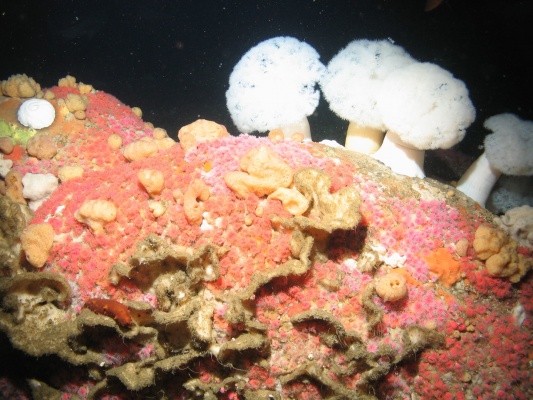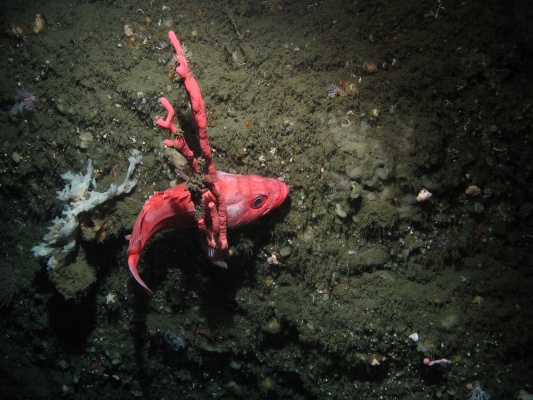The deep sea is a dark, cold environment that includes a variety of habitats from the mid-water region to the abyss. Unique organisms and dramatic geological features lie in the deep waters off northern California.
Based on the topography of the seafloor, the deep sea begins at the continental shelf break, at a depth of about 200 meters (650 feet). Beyond the shelf break, the continental slope descends through the deep sea to the ocean floor.
This habitat encompasses two distinct pelagic zones:
- The mesopelagic zone (from 200 meters below the surface to about 1,000 meters)
- The bathypelagic zone (below 1,000 meters down to the seafloor)
Although the deep sea encompasses 98 percent of all living space on the planet by volume, it is among the least understood ecosystems, because of the challenges inherent in accessing it. However, in recent years, improved sampling techniques and technologies are allowing scientists to explore this habitat in ways never before possible. Researchers are discovering that the diversity of deep-sea fauna is greater than once thought.
Inhabitants
An array of animals – from rockfishes and lingcod, squid and jellies, to corals and sponges – have developed special adaptations that enable them to live under the tremendous water pressure and low oxygen level of the harsh deep-sea environment.
Compared to the relatively shallow water habitats along the California coast, food is generally scarce at depth. For the animals that have adjusted to these harsh conditions and make use of a habitat few others can tolerate, they benefit from reduced competition for food and fewer chances of being eaten.


Organisms have adapted in a variety of ways to this dark world:
- Some animals have extraordinarily sensitive eyes to pick up what little light is available.
- Many make their own light through a chemical reaction called bioluminescence.
- Bright displays of light may be used to communicate, attract mates, create confusion (and thus avoid a predator) or lure food.
Animals must also adapt to the cold water, which slows their metabolism:
- Most deep-sea animals move very slowly, and some employ special enzymes to deal with this unique environment.
- Other animals, like sea cucumbers, carry high levels of unsaturated fat in their cell walls to maintain membrane fluidity in this cold, high-pressure environment.
Conservation and Management Issues
A number of issues affect deep-sea resources in the Cordell Bank, Greater Farallones and Monterey Bay National Marine Sanctuaries.
Seabed disturbance is a concern throughout the region. Bottom trawling is of particular interest; it is widely believed to have negative impacts on benthic habitats, such as modification of the substrate, disturbance of soft-bottom communities and removal of non-target fish species.
Non-sustainable fishing is also a threat. In fact, in 2006, the Pacific Fishery Management Council and NOAA Fisheries closed large portions of the continental slope to trawling in order to protect essential fish habitat (EFH) for groundfishes. Other areas have been closed, also.
Marine debris and carbon dioxide (CO2) sequestration are additional conservation issues in the region. Scientists in the Monterey Bay area are conducting experiments aimed at understanding the chemistry and physics of CO2 in the deep sea and the ecological effects of CO2 sequestration.
Radioactive waste is a particular concern in the Greater Farallones sanctuary. About 47,800 barrels of low-level radioactive waste were disposed there between 1946 and 1970 in the area referred to as the “Farallon Islands radioactive waste dump.”
Monitoring
Scientists strive to understand how deep-sea animals are different from shallow-water species and what adaptations they have developed in response to the deep ocean’s unique environment.
Researchers are engaged in a variety of monitoring studies throughout the three sanctuaries. These include annual West Coast bottom-trawl surveys to monitor groundfish resources.
In the Monterey Bay sanctuary, various surveys explore fish and invertebrate populations in different habitats, such as benthic soft-sediment faunal communities , whale-fall communities and those at the Davidson Seamount .
In another example, the Cordell Bank sanctuary, in partnership with several regional and national groups, has initiated a long-term study to classify habitats and monitor fishes and macro-invertebrates on and around the bank.